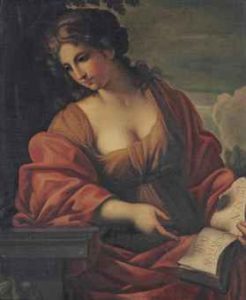
The Cumaean Sibyl, after Giovanni Francesco Romanelli.
The ‘sibyls’ were women in the ancient world that the Greeks and Romans believed to be psychic oracles, with the word sibyl from Latin and the corresponding ‘sibylla’ from ancient Greek meaning a variation of the word ‘prophetess’. These women were priestesses and were known to foretell events at ancient holy sites through the divine intervention of chthonic deities, otherwise known as the deities of the underworlds, such as Hades in Greek religion and Pluto in Roman. As there were many ancient holy sites, there were also many known sibyls around the world.
The acquisition of the Sibylline Books by Lucius Tarquinius Superbus, otherwise known as King Tarquin, is a story that is semi-mythological. The legend states that in around 576BCE, the year of the 50th Olympiad, an elderly woman arrived in Rome offering 9 books of prophesises to the King for an exorbitant sum of money. He refused the books due to the price that she requested, she burned 3 of the texts and offered the remaining 6 to him at the same price. King Tarquin again refused, the stranger burned 3 more and again offered them at the original price. He finally agreed in order to ensure that these prophecies were not lost to the world forever. The original collection of prophetic scrolls are thought to have been written in Greek hexameter verse by a variety of priestesses in the 6th century BCE, continuing into the early Roman era, and were housed in the Temple of Jupiter Optimus Maximum. These texts would have included events from history that had been ‘prophesised’ as well as vague predictions of the future which could easily be associated with many events in a number of similar cultures. The original scrolls were destroyed in the fire of 83BCE and were re-written by a collection of prophetesses, including the Cumaean Sibyl, before being eventually destroyed forever by General Flavius Stilicho in around 405CE. The general was a Christian and as these texts were considered to be pagan due to their association with the ancient deities, they were considered to be evil and a threat to Christianity.
Out of all of the Roman sibyls, the prophetess at Cumae was undoubtedly kept in the highest regard due to her proximity to Rome. She was a priestess who presided over The Temple of Apollo at Cumae; the first Greek colony on mainland Italy which was located near to Naples. Her sanctuary was believed to be located in a nearby volcanic crater, which emphasised her link to the chthonic deities as the crater was also believed to be an entrance into Hades, the Roman underworld. She appears in Book 6 of the Aeneid by Virgil in order to guide Aeneas into the underworld and through the grove of Proserpine with the golden leaves. The Metamorphoses by Ovid also tells a story of golden leaves through the telling of the origin tale of the Cumaean Sibyl. Book 14 narrates how she had lived for over 7 centuries after promising her virginity to Apollo in exchange for living as many years as there were grains of sand in her hand. While he agreed to these terms, she did not and was cursed to live on as a voice without a body.
The legacy of the Cumaean Sibyl is still felt in various locations throughout Italy. She appears on the ceiling of the Sistine Chapel, painted by Michelangelo in the early 16th century in a prominent placing over her fellow sibyls. Her supposed sanctuary is still a popular tourist attraction on the Strada Provinciale Cuma Licola in Naples, cementing the Cumaean Sibyl in the legends of Italy.
-Devon Allen
Junior Girl
Girl Museum Inc.
